Louisiana is disappearing under water – can oysters save it?
 Getty Images
Getty ImagesFrom the boat, the salt marsh looks pristine: cloud-dotted sky, brown-blue water, gold-green grass. As we motor along the coast, a flock of egrets flutters into the air, startled by the only humans in sight. Later, I’m equally startled to see an alligator lazing in the shallows.
It is easy, if you don’t know any better, to think that the world of the wetlands is simple, steadfast, still. That would be incorrect. A salt marsh is an exquisitely complex ecosystem. It is also a crucial one. In Louisiana, where wetlands make up one-third of the state by area, the landscape plays a pivotal role. These waving grasses along the Gulf of Mexico underpin Louisiana’s seafood industry, the country’s second-largest behind Alaska. They are home to key infrastructure, like the pipes that carry oil and gas from the largest US entry port for waterborne crude oil all the way up to Knoxville, Tennessee and Washington DC.
And although the precise magnitude of their effect is still being debated, they are a natural barrier against storm surge, hurricanes and flooding. The wetlands at Biloxi Marsh – a web of bayous, brackish and salt lakes in south-east Louisiana that give way to Eloi Bay, Chandeleur Sound and, finally, to the Gulf of Mexico – help protect even New Orleans, 45 miles away.
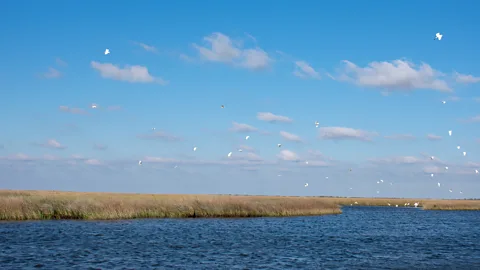 Amanda Ruggeri
Amanda RuggeriThe salt marsh is also a landscape that is changing, fast. From 1932 to 2016 in Louisiana, on average, open water subsumed a chunk of wetlands the size of a football field every hour. It’s true that the rate of loss has slowed. A football field is now being swallowed every 100 minutes, rather than every 34 minutes, when it was at its peak. This is largely because there hasn’t been a major hurricane since 2008. It’s partly because of restoration activities. And there’s another reason, too. “In recent years it’s reached a slowdown, but that’s because the most vulnerable spots are already gone,” says Seth Blitch, director of coastal and marine conservation at the Nature Conservancy of Louisiana. The slowdown, however, isn’t guaranteed to continue.
You might also like:
• Miami’s fight against rising seas
The landscape here always has been changeable. But such enormity of land loss is new. Most of it is due to the Mississippi River levee. Since the levee’s construction in the 1930s, the state has lost one-quarter of its wetlands: just under 2,000 square miles (5,100sqkm). That’s the size of Delaware, or Trinidad and Tobago. If nothing changes, Louisiana will lose another 1,000 square miles (2,600sqkm) – that’s a Rhode Island or Luxembourg of land mass – by 2050.
“My background is ecology, so it’s my first reaction to think about the wildlife habitat that we’re losing. But if you take a step back, this issue goes way beyond that,” says Deb Abibou, restoration programmes director at the Coalition to Restore Coastal Louisiana (CRCL). “The struggle that we’re facing down here doesn’t just mean ‘Oh, we have less land for our houses.’
“It means that we are losing the natural resources that we depend on for our seafood, for our recreation, for our industries, and for our protection of inland communities.”
Some 45 minutes after leaving Hopedale Marina, we pull up to a strip of flat grassy marsh. It looks like the rest of the coastline we’ve seen for the last few miles, with two differences. First, a handful of white PVC poles punctuate the area where the mud meets water. Second, and visible only because we’ve come at low tide, a black border surrounds the marshland, about 20 feet offshore, like a fortification edging a moat.
Just how effective that fortification is what the team is here to test.
 Amanda Ruggeri
Amanda RuggeriWearing waterproofs and rubber boots, the CRCL’s Christa Russell and Jenny Wolff jump out of the boat, unspooling a measuring tape from one white stick in the grass to one in the water. The one in the water used to be on land, too: now, it’s about two and a half feet off. The land has crumbled away entirely.
But the rate at which it has crumbled is good news.
“There’s still land loss,” says Blitch as we bob on the boat, watching a mud-spattered Wolff and Russell pick their way through the grass back to us. “But it’s way slower.”
Several months of data-gathering later, Russell presents the first year’s worth of findings in a New Orleans conference room. The four protected sites lost an average 0.81m of land. At the four control sites, the coastline lost 1.54m. It is still early days. But so far, their project has halved the rate of erosion.
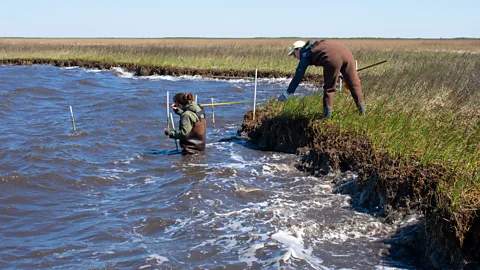 Amanda Ruggeri
Amanda RuggeriThe protection comes from that black ‘wall’ running around the shoreline. But while many man-made seawalls are concrete or rock, this one, about a half mile (0.8km) long in total, is different: it is made up entirely of oyster shells.
*
Finished in November 2016, the reef – the first built by the CRCL and The Nature Conservancy in Louisiana – was a massive project. The 1.7 million pounds (771,000kg) of shell used were contributed by 26 local restaurants, including a dozen in New Orleans. This isn’t the world’s only oyster shell recycling programme; there are similar projects in Texas, New York, San Francisco and the Chesapeake Bay, as well as in Australia. But given the number of oysters that are shucked around the world, these programmes are relatively few.
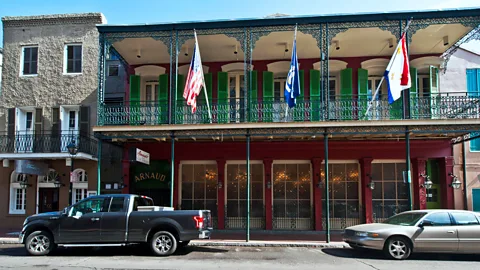 Getty Images
Getty Images“In earlier times, when fishermen and their buyers had a closer relationship, the restaurants would give the shell back to their fishermen. There are maybe one or two restaurants that still do that today,” says Abibou. “At shucking houses, there’s usually an end product for the shell: it’ll get ground to chicken feed or used as pavement. But at New Orleans restaurants, for the most part, they were throwing them into the landfill.”
Russell, who is CRCL’s coastal scientist, puts it more bluntly. “Usually, we are taking shell out of the water and not putting it back, which is ridiculous,” she says.
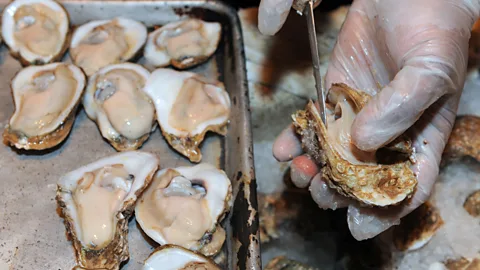 Getty Images
Getty ImagesAfter being collected, the shells were left in the sun for six months to cure, getting bleached free of food particles and bacteria. More than 300 volunteers organised them into 434 ‘baskets’. Each measures 3ft by 3ft by 6ft (1m by 1m by 2m) and weighs 4,000 pounds (1,815kg). They were seeded with the oyster larvae known as spat. And then, finally, the shells came, via barges, to their new home in the marsh.
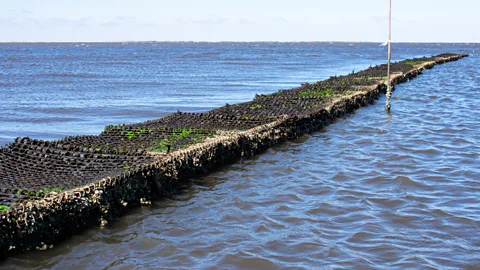 Amanda Ruggeri
Amanda RuggeriThe process may be more difficult than pouring concrete or laying granite. But it was key. “A flat expanse of concrete does not do the same things for an ecosystem that this does,” Russell tells me.
She rattles off the reasons why. By being in the water the shells are, obviously, not in a landfill. The nooks and crannies of oyster shells provide extra surface area, absorbing wave energy and buffering the coastline more than a flat structure. They also offer protection to smaller sea creatures. And the shells allow water, bacteria and algae to flow through them – crucial for the marshes, which use the tidal flow to ‘breathe’.
Seeded with spat before they’re built, the oyster reefs also encourage other oysters to grow. In the last year, the spat has become 286 individual live oysters: not much, but something. And expected to multiply.
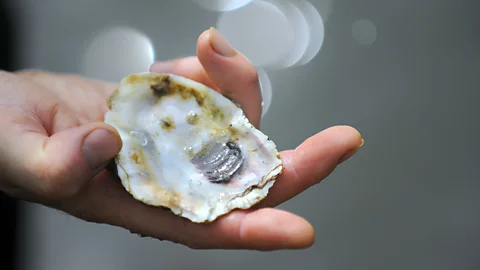 Getty Images
Getty ImagesOne benefit of having live oysters is that the reefs then grow vertically – and can do so faster than sea level is expected to rise. Another benefit is water filtration. Each tiny creature can clean an impressive 50 gallons a day, making them the ocean’s most effective water filters. They also capture and store nitrogen and phosphorus.
All of this is particularly helpful here in the largest estuary system in the US. For 7,000 years, the Mississippi River moved freely. It swept sediment along with it, and as that sediment built up the river would re-route, finding a different path to the Gulf of Mexico. But when the river was leveed, it stayed static. Instead of being deposited in the estuary, all of the sediment now washes out to the Gulf.
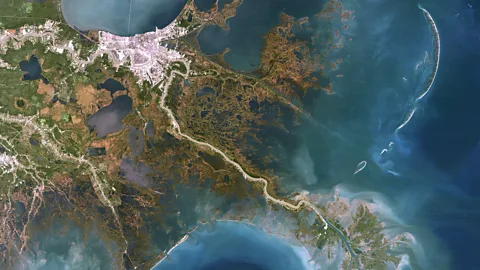 Getty Images
Getty ImagesThis means that as the land naturally subsides, as the soft sediment of an estuary does, it is no longer replenished – the main reason for that Delaware-sized disappearance into the Gulf. And the irony is that, although the levee was built to protect communities and industry from the mighty Mississippi, now it is having the opposite effect. The more marsh is lost, the less protection Louisiana’s residents have against floods, storms and sea level rise. For the two-thirds of residents who live near the coast, this can be particularly deadly.
Abibou frames it in of lines of defence. “At the furthest end, you have your barrier islands as the first buffer. Then you have various types of marshes and coastal forest,” she says. “If you remove all of the natural infrastructure from that, then it’s the sea against our manmade concrete. And nature’s going to win.”
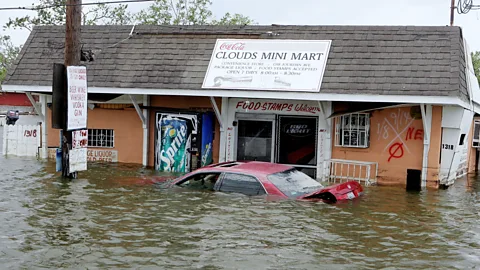 Getty Images
Getty ImagesThe levee also means that the water in the Gulf is turbid and muddy. And that the pollutants nitrogen and phosphorus, staples of agriculture, are increasingly being carried from across the US into the Gulf. The mud and toxins create uninhabitable ‘dead zones’. Fewer plants grow. Fewer roots hold soil together. And so more land is lost.
Animals are affected, too: “Submerged aquatic vegetation and algae can’t get access to light in the same way when the water is really muddy like that,” says Russell. “So they don’t grow the same way – which means the species that depend on them go elsewhere.”
Oyster reefs help with all of this. So do wetlands. In of what the same process would cost with a treatment plant, a single acre soaks up anywhere from $35,000 to $150,000 (£27,000 to £116,000) of pollutants before they get to the Gulf.
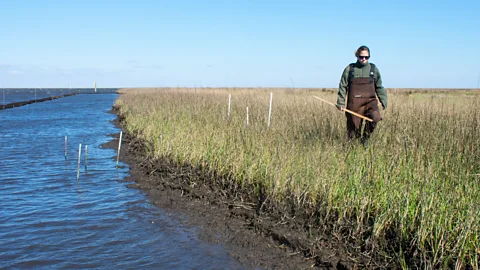 Amanda Ruggeri
Amanda RuggeriBut the world is losing oyster reefs even more rapidly than it is losing marshland. We have lost between 64% and 71% of the world’s wetlands since 1900. Globally, 85% of natural oyster reefs either have been lost or severely depleted due to overharvesting, disease, pollution and declining habitats. In the Gulf, the numbers are a little better: between 50% and 89% of wild reefs have been lost.
*
Against this backdrop, building oyster reefs to buffer Louisiana’s wetlands, instead of laying seawalls made of concrete or granite or (more likely still) of doing nothing, no longer seems like an unwieldy undertaking. Instead, as a solution, it seems elegant. Nature usually is.
The data has borne this out. One study determined that a hectare of oyster reef was worth up to $99,000 (£77,000) per year in of benefits like the habitat it provided for other fish and its effect on water quality – not including the value of those oysters being harvested. In of flood and storm protection alone, an oyster reef provides more value for money than even levees or dykes. In April 2018, a team of scientists published a cost-benefit analysis of projects being done across the Gulf, from building dykes to restoring barrier islands. Costs of construction and maintenance were weighed against the effectiveness of flood and storm protection – calculated using economic models developed by reinsurance company Swiss Re with its partners. (Read more about how the financial industry is developing tools to calculate the risk of climate change and what that could mean for climate resilience projects).
The findings were stark. Anything with a benefit-to-cost ratio above one is, of course, seen as cost-effective. In of reducing risk alone, dykes and levees had a benefit-to-cost ratio of 0.26; beach replenishment in the western Gulf, 0.28. Restoring oyster reefs (7.34) was calculated to be 28 times more beneficial. And restoring wetlands? Thirty-three times more (8.72). The only project with a higher benefit-to-cost ratio was sandbags – but only because of how cheap they were. In of overall risk reduction, the benefit was low.
As Abibou puts it: “We can’t just build levees and hide behind them. We need to have a healthy marsh and healthy wetlands to provide us with adequate risk reduction.”
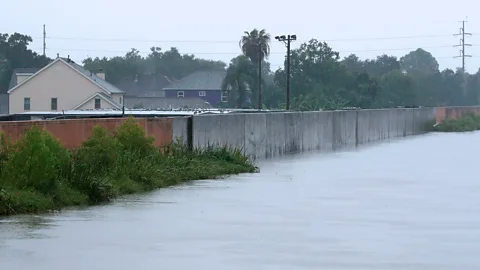 Getty Images
Getty ImagesThen there is the value of the fishing industry in general. Oyster reefs like this one aren’t built to be harvested, of course. But by bolstering the ecosystem, they help. Across the US, about 75% of marketable fish and bivalves rely on salt marshes to survive. In Louisiana, they’re the foundation of the most productive commercial fishing industry of the lower 48 states. Louisiana lands 1.2 billion pounds (544m kg) of fish annually. The next state, Washington, lands 552 million (250m kg). Louisiana’s oysters alone make up one-third of the US oyster industry, crabs one-quarter. It lands more shrimp than Texas, Alabama and Florida put together. If the wetlands were to continue to disappear, if the Gulf were to become a mud- and toxin-logged swamp, it’s reasonable to think that that industry would vanish, too. That would wipe out more than 160,000 fishing jobs alone – never mind the knock-on effect to the food, restaurant and tourism industries.
*
Often lost in the discussion of economic impacts, of what something like erosion or climate change means for humans, is how this kind of habitat has value all on its own. Non-locals may not recognise the names of the grasses that trip off the tongue: hog cane and three-square, saltgrass and glasswort, cordgrass and black rush. But they are strange, special, of value in their own right. Unusually tenacious, they grow out of the low-oxygen sodden soil towards the sunlight. They survive by the tide. When they’re submerged, the ocean brings nutrients and cleans out decay and allows fish to hide and spawn in safety.
The ecosystem nurtures a long list of creatures.The grasses dozens of fungi and bacteria and more than 80 species of spiders and insects. These feed crabs and shrimps and oysters and speckled trout and black drum and sea turtles and flounder, which feed herons and egrets and spoonbills and wood storks and seaside sparrows and marsh wrens, which help spread the seed for grass. Nutria hide here, and rabbits, and snipe, and ducks. Alligators, too. Losing the coast risks losing them all.
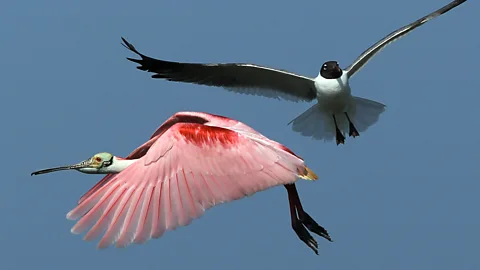 Getty Images
Getty ImagesWe want to put dollar signs on all of it. That’s particularly true before deciding if something is worth saving. And particularly now, with not only industry statistics but with newly sophisticated models for measuring the financial risk of events like coastal erosion and flooding, we can. But that’s only part of the story. The other part is what surrounds us as we head back towards the mainland: egrets fluttering, fish swirling, alligators stalking, grasses waving – and perhaps little oysters moving below us with the tide, searching for a new reef to settle on and thrive.
Amanda Ruggeri is BBC Future's senior editor. She can be found at @amanda_ruggeri on Twitter.
If you liked this story, sign up for the weekly bbc.com features newsletter, called “If You Only Read 6 Things This Week”. A handpicked selection of stories from BBC Future, Culture, Capital, and Travel, delivered to your inbox every Friday.
